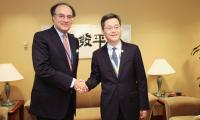Our knowledge of history, economics, and much more owes a lot to the works of Ibn Khaldun. With his usual keen eye, he said that “Government is an institution which prevents injustice other than such as it commits itself.”
What was said 700 hundred years ago still holds true today. The government’s role is key in laying the base for a nation’s progress.
At our Institute for Policy Reforms, I led a project to study what East Asia did to get to where they are today. And the lessons from it have been a revelation. East Asia went about the business of government in a way that is very close to anyone’s idea of how it should be run. Successive governments in Pakistan have made similar claims. But there is a wide gap between words and deeds.
As I said in a previous column, our study looked at causal relations to find out why some economies do well, and others don’t. To achieve sustained growth, an economy needs a national strategy with leaders keen to lead societal change.
That is no easy task. It calls for rigour in planning and a disciplined commitment to governance. That is why what East Asia did is a miracle. The real miracle of East Asia is the effectiveness with which development policies are conceived and implemented. Leaders such as Deng Xiaoping, Lee Kuan Yew, and Mahathir Mohamad who understood this are now the stuff of legends.
The main instrument of the national strategy is an industrial policy. Its aim should be more manufacturing for export growth. The policy will offer incentives based on performance. Export will be a key criterion as would be cost and quality. The eligibility criteria for availing incentives must be quantified to the extent possible with no deviation or compromise. Incentives must have stated sunset. If a firm cannot become a healthy exporter within an agreed period, it must exit.
These industries will get preferred access to capital and forex, tax benefits, R&D and training support. The government should also help with industrial parks and SEZs — the latter to attract FDIs. Selected industries must be those that are one-step above in technology than what exists at
present. The government and industry must build a
channel for exchange of ideas and information.
Two key goals of an economy should be to build more capital stock (new machines and human capital), and produce higher value goods and services. The comparative advantage of East Asian economies changed this way, as the economy developed. The government may fulfil its role through projects selected with care in a larger PSDP.
East Asia began with ensuring political stability, social cohesion and law and order. No nation can progress without these. Macro-stability too is key, as are secure borders that allow trade with the region. Their governments also invested in people and infrastructure to boost competitiveness. One precondition that may pose the most challenge to us is to raise the ability of civil servants to execute the process of change. They must be free of all influence and pressure.
To believe that the above is not possible in Pakistan is to accept that we will forever stay a poor country without respect in the eyes of the world.
Getting to the nuts and bolts of the macro economy, I recommend three measures. Within a year or two, when the economy is stable, we must stop incurring foreign debt for budget support and balance of payments. Such debt should be for the most vital projects. Also, the government must review all imports and, where possible, replace them with domestic substitutes. We must use forex primarily to import key inputs and technology for manufacturing. And the government must end or tax short-term foreign portfolio investment. Such inflows are not a solution. They are a problem. We must stop celebrating them.
The other task is to reduce and gradually end budget deficit. To control borrowing, the SBP may enforce debt limit on the federal government. The other half of this equation is to increase revenue. The FBR is already trying. They must also remove exemptions and ensure that all sectors of the economy are taxed equitably, whether they fall under federal or provincial remit. It is critical that the FBR earn taxpayers’ trust through strict and fair enforcement.
Growth economies offer subsidy to SOEs to induct new technology, product or service. At taxpayers’ expense, the government gives subsidy as a reward for their poor performance. Whether the government wants to reform, restructure or privatize SOEs, they may act early, to reduce the burden on the budget.
In earlier columns, I discussed the unhealthy effect of falling rates of savings and investment on exports and GDP. We must make every effort to increase savings and ensure that they reach the desired productive end. Some East Asian economies fruitfully used Post Office savings. Their massive size went to off-budget infrastructure projects.
In the present times, e-savings platforms have a major potential. We may also review the Overseas Bond initiative and make it more effective. In the 1960s, DFIs were a potent force in Pakistan. They helped rapid growth of industry. The DFIs collected savings and channelled them to industry. Their abeyance almost coincides with stagnation in manufacturing. We must revive DFIs and launch an EXIM Bank.
Pakistan must also become part of the global supply chain. To do so, we must reform a number of areas. For one, the country must improve relations in the region. We must upgrade logistics, quicken port and customs clearance, and have a compatible tax and duty regime. The government must facilitate JVs between Chinese and Pak firms.
For all of this to work, the country needs the right organizations. A manufacturing, investment and export promotion organization must plan, implement and monitor execution of the industrial policy. The PM may lead this organization. It will work with the private sector to select industry, decide incentives and monitor progress.
Sustained growth is possible only through export of higher value goods. The government should set up a Commission on Science and Technology. The commission will help firms acquire the knowledge to manufacture and export value added goods. It will also lead with training, R&D, and enforcing standards so that Pakistan earns a reputation as a producer of quality products.
While the government plays a guiding role for the economy, it does not mean weakening the role of markets. Market is a key force in any economy. East Asia shows that a growth policy supplements the role of markets without diminishing it.
The writer is chair and CEO Institute for Policy Reforms, and a former commerce minister.
The cases of Attabad Lake and Gwadar simply highlight the many tragedies that exist around the country
Reaffirming loyalty to democracy as a problem solver can be a good starting point
Unfortunately, Pakistani films and TV dramas have seldom ventured beyond domestic intrigues and love triangles
A woman walks past a building of the International Monetary Fund. — AFP/FileThe annual and spring meetings of the...
Late Benazir Bhutto's daughter Asifa Bhutto Zardari addresses the Christian community in Bihar Colony on January 23,...







